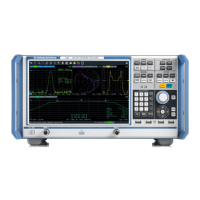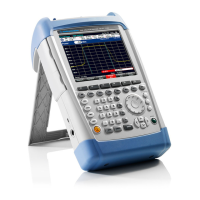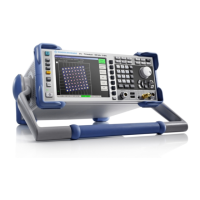SOURce<Ch>:... R&S
®
ZVA/ZVB/ZVT
1145.1084.12 6.266 E-6
<log_port1>,
<log_port2>
First and last logical port number in the port group. The port group
contains all port with numbers between <log_port1> and <log_port2>.
The command generates an error message if only one parameter is
transferred. Both parameters must be omitted if the command is used
as a query.
Range [def.
unit]
1 to n where n is the number of ports of the analyzer. <log_port1> can
be smaller than, equal to or larger than <log_port2>, however, a
physical port cannot be assigned to several port groups. [–]
SCPI,
Command
Types
Device-specific, command or query
Example:
SOUR:GRO1 1,2; SOUR:GRO2 3,4
On a 4-port analyzer, arrange the logical ports no. 1 and 2 in port
group 1, the logical ports no 3 and 4 in port group 2.
SOUR:GRO?
Query the port group no. 1. The response is 1,2.
SOUR:GRO:CLE ALL; SOUR:GRO1?
Dissolve all port group and repeat the query. The response is 1,4: the
default port group no. 1 contains all ports.
SOURce<Ch>:GROup<group_no>:CLEar [ALL]
Dissolves a group of measured ports <group_no> or all port groups.
<Ch>
Channel number.
<group_no>
Port group number. If unspecified the numeric suffix is set to 1.
Range [def.
unit]
Range according to the current port groups
(SOURce<Ch>:GROup<group_no>). If an undefined port group
number is used, the analyzer generates an error message. Exception:
Parameter ALL, see below. [–]
Note: Port group no 1 is always present and can not be dissolved. After
a *RST or after SOURce<Ch>:GROup<group_no>:CLEar
ALL, port group no. 1 contains all ports of the analyzer.
ALL
If ALL is specified, all port groups are dissolved (exception: port group
1; see above); the <group_no> suffix is ignored. If ALL is omitted, only
the specified port group is dissolved.
SCPI,
Command
Types
Device-specific, no query
Example:
See SOURce<Ch>:GROup<group_no>

